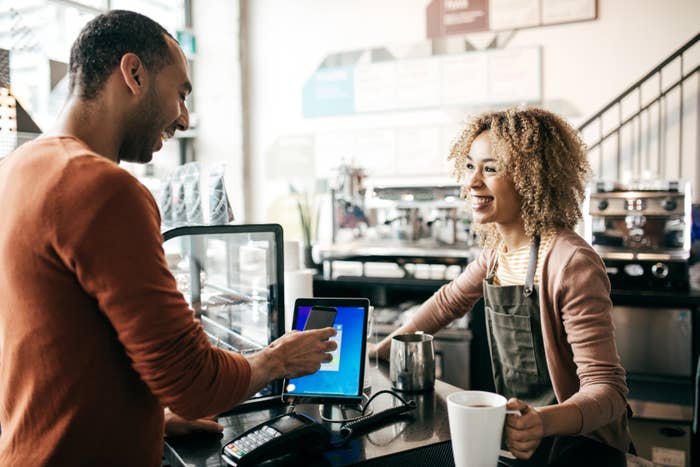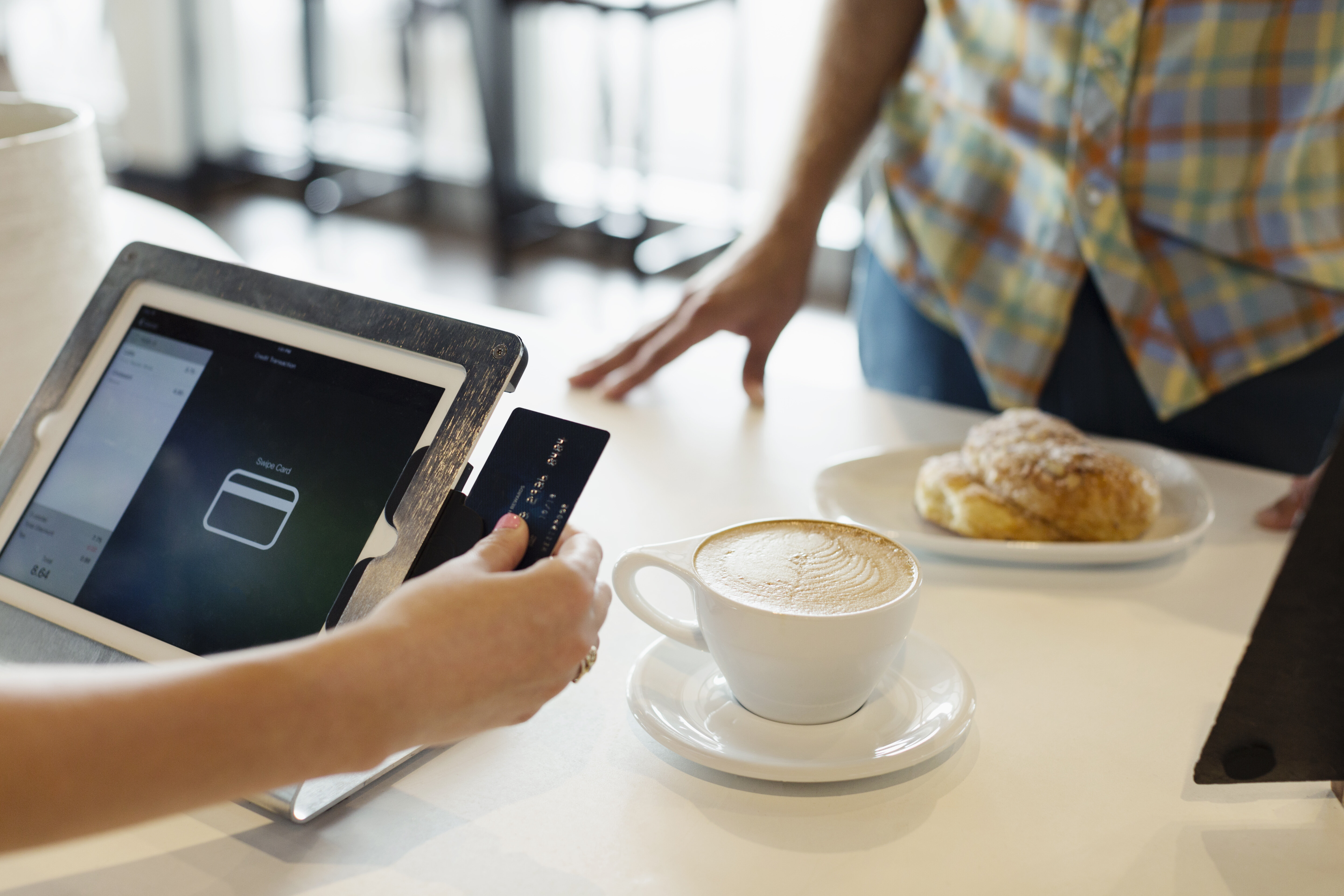It’s early morning, and you just placed a coffee order at your local coffee shop. Maybe the barista asked about your weekend or wished you a good day. It’s a friendly interaction. You go to pay, and the inevitable happens — the barista whooshes the screen in your face, and you’re prompted to tip or not. Suddenly, the experience turns transactional and forced. Do you leave a tip? If so, how much? Will the barista judge you? Or do you just throw a buck in the tip jar if one exists? You ponder that it’s too early to have to answer these questions.

“I think it’s a conversation that people should talk about,” said Catalina, a barista at a specialty coffee shop in the Cincinnati area (she declined to give her last name because she’s new to the shop). “Or maybe I’m just deeper in the coffee community now, so I hear more about it.”
And people sure do talk about it. Take, for example, this assortment of tweets:
Caffeine is integral to Americans’ daily rituals, so why don’t more people tip baristas? According to a Pew report, only 27% of Americans said they sometimes tip baristas; 24% of people said they never do. Factoring in low wages and inflation, not tipping — which is by no means mandatory — can be detrimental to any barista, including one employed by Starbucks.
“I know everybody talks about [how] Starbucks pays their baristas so well. They make the equivalent of $22 an hour, and they have benefits. But you want to support your independent coffee shop,” said Joe Humpert, a former barista and former manager at Northern Kentucky’s Roebling Point Books and Coffee and a two-decade veteran of the coffee industry. “The smaller the coffee shop, the less likely they are to be able to fairly compensate for people. And if the prices of the drinks were raised — because margins on coffee are so narrow — to where you could pay the baristas $15 an hour, your latte would be $10 instead of $5.”
At the gratuity-free Parable Coffee in Columbus, Ohio, a latte starts at $8, meaning they can pay the staff more of a living wage and have a “pay what you like” program. However, it’s a rare business model.
As a rule of thumb, Humpert tips a dollar a drink, even on drip, because of all the additional labor and maintenance that goes into brewing the coffee, cleaning the machines and interacting with customers.
“But if I [order] more than one drink or if I get complicated drinks, or if there’s some conversation that has to take place about what’s going on, then I’ll usually tip more than a dollar a drink,” he said. “Same with a craft cocktail.”
Catalina said tips are a big part of her income, and at times, customers are quite generous with the tips. “People are like, ‘Oh, it’s just a cup of coffee. [A tip doesn’t cost] that much,’” she said.
But sometimes, they don’t want to tip on a drip coffee. “I did find that when I worked in a smaller town, a lot of people were tipping a lot less than in a bigger city,” Catalina said.
One issue that creates a barrier between the barista and the customer is the tipping screen powered by programs like Square and Toast. The screen prompts the customer to tip a certain dollar amount or percentage or not tip at all. Despite that technology, some coffee shops additionally have a tip jar on hand for people to toss in extra change.
“You basically are telling a customer, ‘Don’t walk away yet,’” Humpert said about the technology. “You still need to do stuff. And you’re not saying, ‘Give me a tip,’ but you’re saying, ‘At least hit no thanks and sign it.’ It’s tedious. It’s one of those things where they’re trying to build in conveniences, and they’re trying to make everything more touchless or self-explanatory, and it just ends up creating other problems.”
Catalina said, “People forget to finish the screen sometimes, or they’ll walk away, and I have a harder time asking somebody to finish the screen. I’m still working on that.”
Jonathon Sepulveda, the director of coffee and sales for roaster Utopian Coffee in Fort Wayne, Indiana, got his start in specialty coffee 25 years ago in SoCal as a barista and coffee shop manager.
“I think there’s something about this technology that just puts this odd divide between the barista and the customer where this machine portion of it just turns around and inserts. You must pay for this genuine experience,” he told HuffPost. “And I think that is a challenge for both the barista and the customer. I guess there shouldn’t be any obligation across the board unless it’s genuine. I think that’s how I like to receive tips, anyways — not when it feels like this kind of weird, forced thing.”
At Catalina’s shop, she doesn’t have to turn the screen around, but she thinks tipping should be private. “They can tip if they want,” she said. “I feel like that’s their business. I’m going to walk away and start their drink. That way, I’m not staring at the screen watching them do it. I understand why you wouldn’t tip because it’s your money. If it’s good, you’re going to tip more. If it’s not as good, you’re going to tip less. Now that more people rely on tips, you just should do it anyway.”

Like Humpert, Sepulveda suggested tipping a dollar a drink unless the customer spends a lot of money.
“If you’re buying a bunch of different espresso-based beverages with a ton of different modifications, and your bill is $20-something, a $4 tip isn’t crazy,” he said. “But on a cup of coffee where you’re spending $2, $3, and it’s a 60-cent tip, I think that lines up pretty well.”
Catalina also suggested a dollar tip. “I understand that you usually don’t have as much money to give a big tip,” Catalina said. “It’s different wherever you go. Some people tip $2 on their drip coffee, and some people tip 50 cents. It’s not based on how I’m feeling. It’s more of how much I can pay that day, depending on my expenses.”
Every Dry January, drinkers are expected to examine their relationship with alcohol, but a month dedicated to looking at caffeine consumption doesn’t exist.
“I would argue that coffee is a more essential part of your daily goings-on than alcohol,” Humpert said. “When you go in and expect it to just be there and perfect and on tap all the time, you should acknowledge and show respect for the person making it happen. If you told someone that they could not have an alcoholic beverage on a certain day, they would probably be fine with it. They’d survive. If you told them they couldn’t have a cup of coffee or some other source of caffeine in the morning, most Americans would lose their mind.”
As Sepulveda pointed out, the barista is both the front and back of the house and is expected to do more work. Plus, the first interaction people might have in the morning is with their neighborhood barista.
“When you go and get your first cup of coffee in the morning, you haven’t been drinking already,” Humpert said. “You really feel like you need it. And if it’s bad, you’re never going to forget that experience. You’re not going back to that coffee shop again. So the stakes are much higher.”
In 2022, the average price of a cup of coffee at a coffee shop hit almost $5, so leaving a small tip shouldn’t seem outrageous.
“If you’re already spending basically cocktail prices for your coffee in the morning, why can’t you throw a dollar to the person who made it for you and tried to make it exactly the way you want it?” Humpert said. “I’m thinking of the people who would contest this, and I’m like, you literally spend $50 on coffee a week.”
Sepulveda sees tipping as a cultural issue rather than a right or wrong one. “It’s within our culture to do it, and whether or not we’re expected to do it or not, it’s just different,” he said.
Consumers must comprehend what goes into making their lattes and cold brews and tip appropriately. People tip bartenders for merely cracking open a can of beer or simply pouring a pint, so giving an extra buck to your local barista who spends time brewing batches of coffee throughout the day or using more time-consuming methods like the pour-over should be normalized.
“I think the act is what counts,” Catalina said. “I’m not going to be like, ‘Oh, they only tipped 50 cents.’ I appreciate anything. I think it should be a regular thing that people do.”
This post was previously published on HuffPost.
